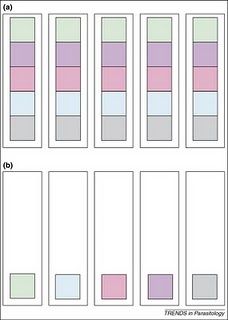What's a Manta do?
 Thursday, April 8, 2010 at 9:30AM
Thursday, April 8, 2010 at 9:30AM Manta rays (Manta birostris) surely vie for the title most spectacular among the large animals in the ocean. Not only do they grow to enormous sizes, but they are placid, graceful, and generally unafraid of humans, which means we can get close to them in the water and really appreciate how incredible they are, up nice and personal. I always thought that mantas were a one-of-a-kind species - the only member of its genus - like humans, whale sharks, koala bears or killer whales. Luckily, Andrea Marshall is not like me. She and her colleagues took a closer look at the body features, colours and patterns on lots of mantas from all around the world and they concluded that there are at least two, and possibly even three, manta ray species. They’re not the first people to propose this, so technically what they have done is “resurrect” the name Manta alfredi, the Prince Alfred manta, which had been made a synonym of Manta birostris some time ago (read the paper for the full sordid taxonomic history of mantas). The differences between the two species are subtle and mostly to do with the colour of the lips, wings and shoulders, the spots on the belly and the presence or absence of a bony mass near the base of the tail, but nonetheless they probably reflect real differences between the animals and, under the current definition of “species”, they probably cannot successfully interbreed. The third potential species they call “Manta sp. cf. birostris” which is taxonomist shorthand for “as-yet undescribed manta species sort-of like M. birostris”.
If you have ever been to the Georgia Aquarium, you may have seen one or both of their mantas in the Ocean Voyager exhibit. If you look closely at these and compare them to the Marshall paper, you’ll see that one (called “Nandi”) is Manta alfredi and the other (“Tallulah”) is more like Manta sp. cf. birostris. Its slightly ironic that in light of this new paper, neither of them is the “actual” or original “manta ray”. Of course, they are both still spectacular animals!Who cares about all this anyway? What does it matter if there’s one or three or a dozen manta species? As it happens, it matters a great deal! Taxonomy underlies everything else in biology. What good is a population estimate, for example, if that estimate confuses two species? We would grossly overestimate both, potentially leading to overexploitation. More generally, how can we understand migration patterns, breeding grounds, diets, ecological roles or behaviour, if we are constantly confounded? These are, of course, somewhat self-centered concerns about the quality of our science or management decisions; a species count is about the most fundamental measure of nature that we have, and those sorts of diversity stats are predicated on a decent taxonomy. Consider this: how much of a ginormous “oops!” would it be if we were to protect a species in one area of ocean, only to learn that the animal in the area we didn’t protect was actually a different species? Perhaps a more important reason it matters is for the mantas themselves and the rest of their ecosystem. Each species has an intrinsic right to exist and a value to the ecosystem its part of.
I just love the idea that even for familiar, charismatic mega-animals like mantas, if we look a little closer, nature shows us hidden diversity: surprising, unexpected, and exciting.
Marhsall, Andrea D., Compagno, Leonard J.V., & Bennett, Michael B. (2009). Redescription of the genus Manta with resurrection of Manta alfredi (Krefft, 1868) (Chondrichthyes; Myliobatoidei; Mobulidae) Zootaxa, 2301, 1-28





